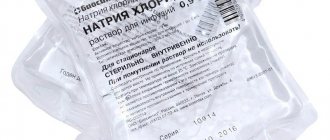Albumin solution d/inf 20% 50ml
Compound
Active substance: 1 ml human blood plasma proteins 200 mg, incl. human albumin is not less than 96%. Excipients: sodium chloride, acetyltryptophan, caprylic acid, hydrochloric acid, sodium hydroxide, water for injection.
Pharmacokinetics
Under normal conditions, the average half-life is 19 days. The balance between synthesis and elimination is usually achieved by regulating the response.
If albumin is replenished externally, equilibrium is established within approximately 48 hours of drug administration. After 1-3 hours of infusion, an increase in circulating blood volume is established due to the diffusion of fluid from the interstitial space.
Indications for use
- Hypovolemic shock;
- burns;
- hypoproteinemia with or without concomitant tissue edema (after major surgery, in sepsis);
- acute respiratory distress syndrome in adults (with volume overload combined with the use of diuretics);
- acute liver failure (to maintain oncotic pressure and bind excess plasma bilirubin);
- hemolytic disease of newborns (in order to bind free bilirubin);
- when removing biological fluids rich in protein (ascites, peritonitis, mediastinitis);
- resuspension of red blood cells;
- acute nephrosis (together with diuretics in the absence of effect from steroid therapy);
- hemodialysis (with the development of hypovolemic shock and hypotension during the session).
Contraindications
- Chronic heart failure degree II-III;
- severe anemia;
- hypervolemia;
- pulmonary edema;
- hypersensitivity to albumin or any components of the drug.
Directions for use and doses
Individual, depending on the indications and clinical situation.
Storage conditions
Store the drug at a temperature of 2 to 25 C. Do not freeze. Keep out of the reach of children.
Best before date
3 years. Do not use after the expiration date stated on the package
special instructions
Allergic reactions/anaphylactic shock
Any suspicion of allergic or anaphylactic reactions requires immediate discontinuation of the drug. If shock develops, standard antishock therapy should be used.
Because this drug is made from human blood plasma, it may carry a risk of transmitting infectious agents, such as viruses and, theoretically, Creutzfeldt-Jakob disease. This also applies to unknown or new viruses and other pathogens.
The risk of pathogen transmission is reduced by screening plasma donors for possible past exposure to certain viruses, by testing for current infection with certain viral infections, and by inactivating and/or removing certain viruses. The measures taken are considered effective for enveloped viruses such as HIV, hepatitis B virus, hepatitis C virus, as well as for non-enveloped viruses such as hepatitis A virus and parvovirus B19. It is strongly recommended that each time Human Albumin is administered to a patient, the name and batch number of the drug are recorded in order to establish a connection between the patient and the batch of the drug.
Hemodynamics
Do not administer without careful monitoring of hemodynamic parameters, monitor for the development of symptoms of cardiac or respiratory failure, renal failure, or increased intracranial pressure.
Hypervolemia/hemodilution
Human albumin should be used with caution in conditions in which hypervolemia and its consequences or hemodilution may pose a particular risk to the patient. Examples of such conditions are: decompensated heart failure, hypertension, varicose veins, pulmonary edema, hemorrhagic diathesis, severe anemia, renal and postrenal failure. The rate of administration should be selected in accordance with the concentration of the solution and the hemodynamic parameters of the patient. Rapid administration may result in circulatory overload and pulmonary edema. At the first clinical signs of overload of the cardiovascular system (headache, shortness of breath, blockage of the jugular veins) or increased blood pressure, increased pressure in the central vein and pulmonary edema, administration of the drug should be stopped immediately.
Application in pediatric practice
The safety and effectiveness of human Albumin solution in pediatric patients has not been established, however, no additional risks of using this drug in children, in addition to the risks that exist when using it in adults, have not been identified.
Large volumes
When replacing relatively large volumes, it is necessary to monitor the parameters of the coagulation system and hematocrit level. It is necessary to ensure adequate replacement of other blood components (clotting factors, electrolytes, platelets and red blood cells). It is necessary to strictly monitor hemodynamic parameters.
Electrolyte status
When administering human Albumin, the patient's electrolyte status should be monitored, and the necessary measures should be taken to restore and maintain electrolyte balance.
Blood pressure
The increase in blood pressure after infusion of human Albumin necessitates careful monitoring of the patient after injury or after surgery in order to identify and treat damaged vessels that might not bleed at lower blood pressure.
Application, handling and disposal
Human Albumin solution should not be mixed with other drugs, incl. with whole blood and blood components, but may be used as a concomitant drug if medically appropriate.
Do not use if the solution becomes cloudy or the seal of the bottle is broken. Before use, preparations for parenteral administration should be visually inspected for the presence of mechanical inclusions and color changes, if the solution and container allow this. If leaks are detected, the drug must be thrown away.
There is a risk of hemolysis, with potentially fatal consequences, as well as a risk of acute renal failure when using sterile water for injection to dilute human albumin at concentrations of 20% or higher. Recommended solvents include 0.9% sodium chloride or 5% dextrose in water.
Conditions for dispensing from pharmacies
On prescription.
Dosage form
Solution for infusion.
Use in children
Possible use depending on the clinical situation.
Pharmacodynamics
A plasma replacement agent obtained by fractionating plasma and serum from healthy donors. Replenishes the deficiency of blood plasma albumin, maintains colloid-osmotic (oncotic) blood pressure, quickly increases blood pressure and blood volume, promotes the transition of fluid from tissues to the bloodstream, and has detoxification properties. Albumin is a natural protein that is an integral part of the protein fraction of human blood, with a molecular weight of 69,000 daltons. Normally, albumin makes up approximately 60% of human blood plasma. The protein molecule albumin contains all 20 amino acids. Albumin synthesis occurs in the liver. Albumin performs a number of functions in the body. Its main function is to maintain colloid-oncotic blood pressure. Albumin solution 100 mg/ml is an effective means of correcting hypoalbuminemia of various origins, impaired central and peripheral hemodynamics, water-electrolyte balance, and has detoxification properties. Albumin binds and transports pigments (bilirubin), fatty acids, certain metal ions, and medicinal substances into the body. In addition, albumin binds toxins and inactivates them.
Side effects
From the digestive system: nausea, vomiting, hypersalivation are possible.
From the cardiovascular system: arterial hypotension, tachycardia.
Allergic reactions: possible urticaria; rarely - anaphylactic shock.
Other: possible increase in body temperature, pain in the lumbar region.
Use during pregnancy and breastfeeding
During pregnancy, the use of human albumin is possible only in cases of extreme necessity. There are no data on the safety of human albumin during lactation.
Interaction
With simultaneous use of human albumin with ACE inhibitors, the risk of developing arterial hypotension increases.
Overdose
Significantly exceeding the dose and increasing the rate of administration can lead to hypervolemia.
Impact on the ability to drive vehicles and operate machinery
There are no data on the effect of human Albumin on the ability to drive a car and work with other machines and mechanisms.
Human albumin (Albuminum humanum)
Intravenous drip or stream. A single dose of the drug depends on the concentration of the albumin solution, the initial condition and age of the patient. Albumin solutions of 5-10% are administered in a dose of 200-300 ml; if necessary, the dose of a 5% solution can be increased to 500-800 ml.
A 5% albumin solution is administered at a rate of no higher than 50-60 drops per minute. A single dose of 20% albumin is 100 ml. Albumin solutions of 10-20% are administered at a rate of no higher than 40 drops per minute. The rate of administration of 5-20% albumin is adjusted depending on the patient's hemodynamic response. Albumin solutions can be injected in a stream during shock of various origins in order to quickly increase blood pressure. In elderly patients, the use of concentrated (20%) solutions and rapid administration of 5-10% albumin should be avoided, as this can lead to overload of the cardiovascular system.
Hypovolemia - 25 g of albumin (500 ml of 5% albumin or 100 ml of 25% albumin) intravenously at the maximum rate tolerated by the patient. Repeat if there is no adequate response within 15-30 minutes.
Hypoproteinemia - 50-75 g of albumin (25% solution) at a rate of 100 ml in 30-40 minutes. For slow infusion - 50 g of albumin in 300 ml of 10% glucose at a rate of 100 ml/hour.
Burns—therapy begins with the administration of large volumes of crystalloids to maintain plasma volume. After 24 hours, albumin can be added at an initial dose of 25 g and then titrated to maintain a plasma albumin concentration of 25 g/L or a protein concentration of 52 g/L.
Acute nephrotic syndrome - 25 g of albumin in the form of a 25% solution is administered in combination with diuretics once a day for 7-10 days.
Extracorporeal circulation - 5% or 25% albumin in combination with crystalloids (priming the device before use) to achieve a plasma albumin concentration of 25 g/l or a hematocrit of 20%.
Ascites - to maintain cardiovascular function after laparocentesis and removal of large volumes of fluid: 4-8 g of albumin per 1 liter of removed ascitic fluid.
Hemodialysis (for long-term hemodialysis and a tendency to shock and hypotension or for the treatment of shock or hypotension in hypervolemic patients who cannot tolerate large volumes of crystalloids) - intravenously 25 g of albumin in the form of a 25% solution.
Dilution after transfusion of red blood cells is 20-25 g of albumin in the form of a 25% solution per 1 liter of red blood cells.
Therapeutic plasmapheresis - 5% albumin if plasma loss is more than 20 ml/kg during one procedure or more than 20 ml/kg per week with multiple plasmapheresis.
Use in children
5% albumin - acute or subacute loss of plasma, for example due to burns, pancreatitis, trauma or complications of operations, plasma exchange. Hypovolemia - 2.5-12.5 g or 0.5-1.0 g/kg intravenously by drip at the maximum rate tolerated by the patient. Repeat in the absence of an adequate response after 15-30 minutes. Burns - Begin with crystalloid administration to maintain plasma volume. After 24 hours, albumin can be added at an initial dose of 25 g and then titrated to maintain an albumin concentration of 25 g/L or a protein concentration of 52 g/L.
20% albumin - severe hypoalbuminemia, accompanied by a reduced plasma volume, generalized edema, when it is necessary to limit the intake of salt and water in plasma replacement solutions; as an adjunct to exchange transfusion in the treatment of hyperbilirubinemia in newborns (1 g/kg 1-2 hours before or during exchange transfusion to bind and remove bilirubin).



